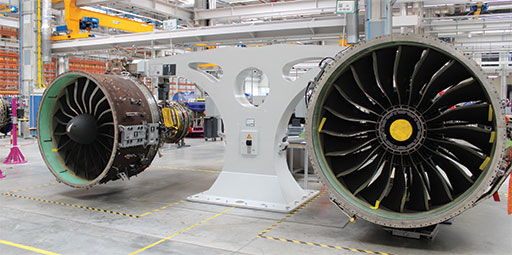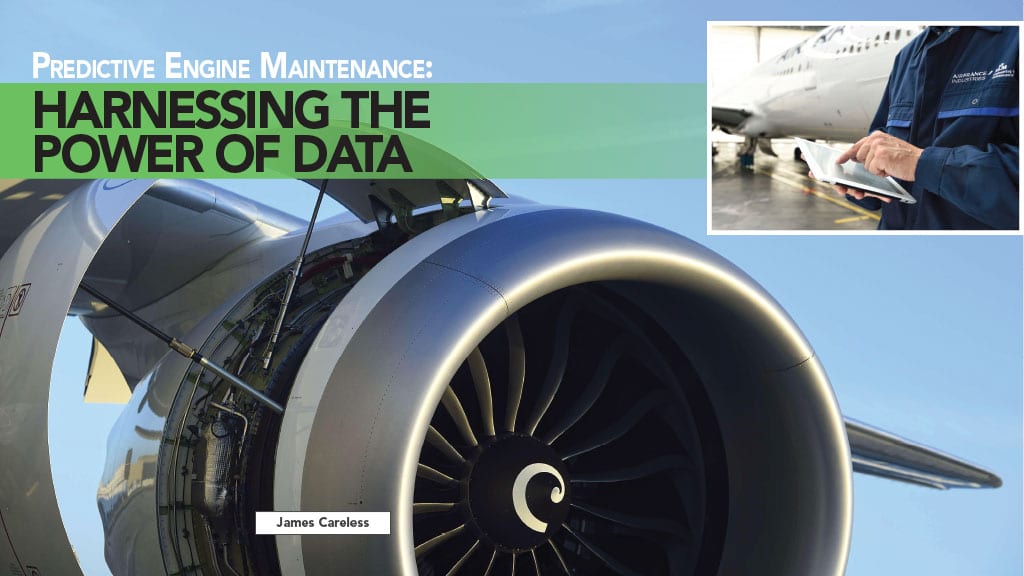Predictive engine maintenance harnesses the power of engine sensor data, digital monitoring/transmission tools, artificial intelligence-enabled big data analysis, and modern digital modeling techniques such as “digital twins” (creating virtual versions of engines whose “operational lifespans” mirror their physical counterparts) to predict maintenance issues before they occur.
By using this predictive approach, engine MROs can address issues for their aviation customers before they become serious, expensive, and likely to cause Aircraft on Ground situations. PEM also allows aircraft owners/operators to base some of their maintenance cycles on actual needs rather than fixed time periods. In this way, less money is spent on maintenance, without compromising safety or aircraft availability.
These reasons explain why PEM is proving to be a popular option for aircraft owners/operators. To get a sense of what kind of PEM solutions are available today, trends in PEM evolution, and how this approach is catching on, Aviation Maintenance magazine spoke with three “PEM players.” They are Rik van Lieshout, digital products and services manager for Air France Industries KLM Engineering & Maintenance; Ville Santaniemi, customer success manager and partner with QOCO Systems Ltd.; and Dr. Michael Bartelt, director of industrial engineering at MTU Maintenance.
What They Have to Offer
To put their expertise into context, Aviation Maintenance asked each company about its role in the PEM marketplace.
Since 2016, AFI KLM E&M has included predictive engine maintenance as part of its PROGNOS predictive maintenance suite, which also handles “health monitoring” for aircraft. “Based on our extensive knowledge of operations and data generated by aircraft engines, AFI KLM E&M’s engineering teams have developed algorithms to provide early warning of engine failures (or of their components) before they occur, and to provide corroborating data to support the Maintenance Center in assessing engine remaining health in order to extend engine Time-on-Wing,” said van Lieshout.
For the record, AFI KLM E&M uses its own algorithms to drive its PEM application PROGNOS for Engine. PROGNOS for Engine is an integral part of the PROGNOS predictive maintenance suite, which also includes PROGNOS for Aircraft, PROGNOS for APU and PROGNOS for Inventory.
MTU Maintenance is also harnessing digital technology to support its PEM services. “We are working towards the point where developments could be called ‘prescriptive’ in that data gathered from operations — such as operational environments, derate, and engine performance — is getting connected in such a way that we are able to forecast remaining on-wing time and optimal engine and module removal points,” Bartelt said. “For that purpose we use our proprietary Engine Trend Monitoring (ETM) called WebETM 3.0, which we have been continuously enhancing for over 15 years.”
MTU Maintenance’s WebETM 3.0 is designed to serve as a full-scale performance analysis tool. In addition to its continuous monitoring of all relevant engine parameters (including specific fuel consumption, rotor speeds, vibrations, oil pressures and temperatures), this tool has a built-in alarm function that alerts users whenever engine conditions are about to exceed critical parameters. WebETM 3.0 is also designed to predict performance degradation on an engine module level.
When taken as a whole, these PEM capabilities allow MTU Maintenance “to create customer-specific workscopes,” said Bartelt. “Combining WebETM 3.0 with other digital services, like our own fleet management tool CORTEX, also allows for better assessment and prediction of material consumption.”

AI-enabled CORTEX allows MTU to generate engine fleet management scenarios and workscopes for its customers that are customized, relevant and proactive. “With CORTEX, we provide optimized support by calculating a multitude of scenarios that can be immediately and endlessly adapted to financial, technical, operational, and market considerations as they change — which we are experiencing regularly at this time,” he said. “Furthermore, we have developed our own scrap rate prediction tools. Based on engine and maintenance data, such as engine operations, severity, material data of parts, and modification status of parts, our AI can predict default probabilities of high-cost material. This information also helps us design individualized maintenance strategies for our customers.”

MTU Maintenance
Meanwhile, QOCO Systems plays a different role in PEM. Rather than do engine monitoring and repairs itself, QOCO Systems provides the data pathways to enable “the leading players in the market to seamlessly share data needed for PEM,” said Santaniemi. “By collaborating and sharing data, airlines and OEMs can jointly improve the utilization of the assets for the benefit of both parties. For aircraft engines, this means extended time on-wing, less unscheduled maintenance, and longer maintenance intervals, leading to improved cost and resource efficiency and streamlined operations at the airline.”
To be specific, QOCO Systems provides the data exchange platform — EngineData.io — that enables bidirectional maintenance and engineering data flows between operators and OEMs/ analytics service providers. “EngineData.io is a key element of our customers’ PEM solutions in making the real-time digital twins of their assets possible,” he said.

QOCO Systems
PEM Trends
Having established what roles these companies play in the PEM marketplace, Aviation Maintenance asked what specific trends are influencing the development and availability of PEM to aircraft operators.
For AFI KLM E&M’s van Lieshout, the two trends making a difference are the ones that make PEM possible, namely the ability of engines to generate data and the progress in artificial intelligence in analyzing this data and drawing conclusions, predictions, and recommendations based on it. “The latest generation of engines allow these developments,” he said. “However, it is the engineering expertise linked to the knowledge of the operations that allows the interpretation of these data and information flows.”

According to QOCO Systems’ Santaniemi, the ever-increasing range, detail and selection of data being generated by today’s engines are driving a trend toward ever-improving PEM capabilities, accuracy, and results. “The more data available to learn from, the more accurate the predictive maintenance solutions are,” he said. “As a result, PEM systems developed by OEMs and analytics service providers will far outshine those developed by individual airlines themselves. To maximize results, data sharing between airlines and PEM service providers is essential.”

AFI KLM E&M
One more trend is driving PEM performance improvements, namely the ongoing evolution in data sampling technologies and the AI-enabled software to analyze their results.
“We see a trend towards working with continuous data at higher sampling rates in order to cover critical operational conditions and maneuvers,” said MTU’s Bartelt. “Going forward, we will see an increase in the amount of data available, such as higher sampling rates, more collected data points, and so forth.”
In saying this, Bartelt noted that further progress will be governed by how much sampling and data transmission technology improves going forward. “In that same vein, the development of new AI methods to better evaluate operational data and predict engine conditions will play an important role,” he said. “Ultimately, we will see a move from predictive maintenance towards prescriptive maintenance, where recommendations for action are provided automatically.”
PEM’s Payoffs
The real value of PEM is its promise to provide customers with proactive engine maintenance that is tailored to each engine’s unique needs, on an as-needed basis that minimizes time in the shop while maximizing aircraft availability. And let’s not forget money/time saved through avoiding unneeded maintenance and AOG situations, all of which are major points in PEM’s favor.
So is PEM paying off on its promise to aircraft owners/operators? According to the experts interviewed for this article, the answer is a resounding yes.
“When it comes to predictive maintenance, it is important to maximize time on wing, but also to prevent costly operations by anticipating breakdowns before they occur,” said van Lieshout. “Removal before failure avoids costly shop visits but also prevents AOG situations that generate multiple costs. These include maintenance intervention and temporary unavailability of the total asset — the aircraft — plus compensation to passengers and a lower brand reputation.”
“Time on wing for engines may even double thanks to the advanced digital services that are enabled through maintenance and engineering data exchanges,” added Santaniemi.

AFI KLM E&M image.
Over the 15 years that it has offered its proprietary ETM to engine clients, MTU Maintenance has seen a number of positive payoffs from this technology in terms of engine availability, reliability and servicing costs. The big one is alerting customers any time the monitoring data indicates something amiss: “We have an ETM support team that evaluates and communicates the technical recommendations to our customers on a daily basis,” said Bartelt. “These recommendations cover line maintenance and shop visit actions to avoid additional damages or performance losses. As a result, this creates savings and shorter turn times.”
“We combine ETM with our engineering and workscope expertise to optimize solutions for customers,” he added. “Essentially, it is always a holistic and highly customized process, where failure cases can be identified, identification and confirmation can happen earlier, and troubleshooting efforts can be reduced, leading to higher engine reliability and time on wing.”
PEM’s Impact on the Industry
PEM’s usefulness to aircraft owners/operators is clear. But what does the PEM model mean to MROs and supporting companies such as AFI KLM E&M, MTU Maintenance and QOCO Systems? What is PEM’s impact on their businesses, and the aviation maintenance industry as a whole?
The answer: PEM is proving to be good for business. “QOCO’s data exchange service is already enabling PEM for more than 10 airlines and about 200 aircraft, and we have ongoing projects for doubling these figures in the next year,” said Santaniemi. “We see that there is definitely a place for us to grow and bring the leading aviation industry players together to jointly develop win-win-win solutions for the industry.”
PEM is also helping MTU run its business better by supporting targeted shop visit planning and preparation. “In addition to fleet staggering, the information is used for strategic material planning,” Bartelt said. “At the same time, by offering these continually improved upon services to our customers, it is possible to increase their engine reliability and optimize shop visits staggering and cost across their engines’ lifecycles.”
What’s Coming Next
PEM benefits everyone in the aviation industry, from aircraft owners/operators to passengers and others who need reliable air travel, plus the OEMs, MROs and related companies that keep them all flying.
Going forward, “predictive maintenance, whether for engines or other aircraft components, will gradually evolve with new developments and innovations,” said van Lieshout. “Meanwhile, predictive maintenance is making a major contribution to a more sustainable aviation industry. This is why our PROGNOS predictive maintenance suite has been awarded the right to use the Solar Impulse label.” (This label is provided by the Solar Impulse Foundation, which has identified 1000-plus clean and profitable solutions on the market today.)

PROGNOS’ environmental benefits include reduced flight cancellations that would otherwise result in extra flights to recover grounded passengers, and cutting the number of Quick Return Flights (return of the aircraft to its departure airport) on technical alerts, which requires fuel to be dumped prior to landing. “It also optimizes overall aircraft fuel consumption by monitoring the status of equipment more precisely,” van Lieshout said.
The technology behind PEM can be extended to other parts of the aviation industry, noted Santaniemi. “We see that by enabling efficient data sharing, there are huge opportunities for many additional services that will eventually drive maintenance costs down,” he explained. “By sharing data, parties that are in the best position to offer services can do so for the benefit of the whole industry.”
“Big data is expected to transform the industry by enabling proactive analysis, as opposed to the reactive analysis seen up to this point,” agreed Bartelt. “There is certainly a lot of potential in digitalization, but also a lot of work and analysis that still needs to be done. Integration of multiple data sources will be key. We expect this to be a continual process over the coming years.”
Faced with these possibilities, the three companies are making plans to capitalize on the PEM/predictive maintenance trend.
“AFI KLM E&M’s main focus is to create value for its 200 airline customers by maximizing fleet availability and asset value,” van Lieshout said. “Future developments will take advantage of progress in terms of AI and big data via new algorithms for more transparency, access to more and more targeted information, and thus cooperation focused on value-added actions.”
“QOCO Systems is constantly improving and extending the EngineData.io platform to support wider maintenance and engineering data scope and to provide additional services for all parties involved,” said Santaniemi. “These include continuous verification and validation of data quality, extended use of common data models/standards.”
At MTU Maintenance, “we believe the next technology advancements in the MRO business will be driven by digitalization, and that is where the greatest development will take place across the industry,” Bartelt said. “To make this happen, we’re working towards full data integration throughout the entire product lifecycle and as a result, improving the predictability of engines. It is our aim to enable ETM to provide technical guidance to our customers with maintenance decisions. This is a development area and will be our focus for the next few years.”
All told, the data, technology and AI-enabled software that are driving PEM today will drive the entire aviation industry in the years to come. In fact, predictive maintenance will likely define how aircraft are designed, operated and serviced in all aspects, making AOG situations an unusual oddity rather than common occurrences. One can only hope.
